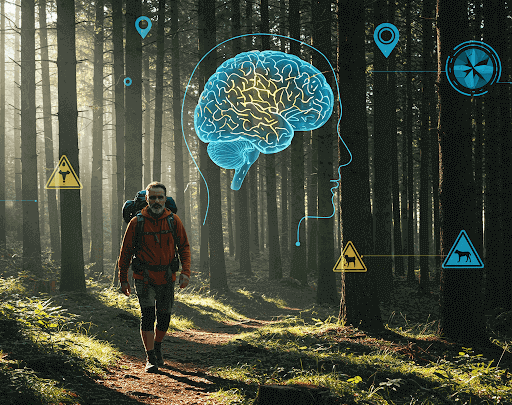Radiant Breathwork blog
Unlock the Superpower You Didn’t Know You Had:
Neuroception
Jon - Radiant Breathwork,
12 February 2025
"Safety isn't the absence
of threat, it's the presence
of connection"
-
Gabor Mate
Neuroception is your body’s unconscious radar, constantly scanning for safety or danger. When balanced, it fosters calm, trust, and connection. But when dysregulated by trauma or stress, it can lead to hypervigilance, social anxiety, and strained relationships.
Introduction
Have you ever leapt out of harm's way before fully registering the danger?
That lightning-fast response often saves you from potential threats thanks to a little-known mechanism in our nervous system called neuroception.
What is neuroception?
Neuroception Shapes Your Perceptions, Emotions, and Behaviours
Coined by Dr. Stephen Porges, the pioneer of the Polyvagal Theory, neuroception is your body’s built-in radar system silently scanning your environment for safety or danger, even before your conscious brain gets involved. It's a remarkable process, but when dysregulated, it can also profoundly shape your reality in ways that aren’t so nice.
Let's explore neuroception, how it influences your world, what happens when it's out of balance, and how you can recalibrate this internal superpower through healing practices like somatics and conscious connected breathwork.
At its core, neuroception is the unconscious evaluation of safety or threat in our environment. Unlike conscious perception, which relies on active awareness, neuroception works behind the scenes.
Imagine hiking on a forest trail: your eyes catch a dark, sinuous shape on the ground. Before you even recognise it as a snake (or just a branch), your brain has already sent an alarm to your body, triggering an instinctive recoil. That's neuroception.

This unconscious process activates your autonomic nervous system (ANS), which controls your fight, flight and freeze responses. It happens in milliseconds, ensuring your survival without requiring conscious thought.
Neuroception isn't just for moments of acute danger—it's constantly working to shape how we interpret and interact with the world.
How Neuroception Works
Neuroception is a filter through which you view your environment, shaping your perceptions, emotions, and behaviours.
It doesn't just react to external threats like snakes or strangers; it also monitors internal signals, like a racing heartbeat or shallow breathing, and adjusts our emotional state accordingly.
Here's how it influences us:
- Our Interpretation of Ambiguity: When neuroception signals safety, we're more likely to view neutral stimuli positively. But when it detects a threat, even ambiguous cues can feel hostile or dangerous. This can explain why a simple glance or comment might feel reassuring in one moment and threatening in another, depending on our nervous system's state.
- Our Emotional Reactions: Neuroception heavily informs our feelings. A calm neuroception state promotes relaxation and trust, while a state of perceived threat can trigger fear, anger, or withdrawal.
- Our Relationships: Since neuroception dictates whether we feel safe or unsafe around others, it significantly impacts social connections. A regulated neuroceptive state fosters openness and intimacy, while dysregulation can make relationships feel strained or unsafe.
What Happens When Neuroception Is Dysregulated?
Dysregulation means the nervous system is out of balance, making it harder for your body to breathe, digest food, or stay calm. It’s like a control panel that isn’t working correctly, causing mixed-up signals.
Trauma, chronic stress, and anxiety can wreak havoc on neuroception. When this system is out of balance, it can mistakenly perceive safe situations as threatening or fail to recognise danger.
- Trauma: For those with trauma, the nervous system may remain in a hypervigilant state, constantly scanning for danger— even in peaceful settings. This heightened alertness can make it hard to relax, trust others, or feel grounded.
- Social Anxiety:
In everyday interactions like small talk or group settings, dysregulated neuroception might cause fear, anxiety, avoidance, and feelings of isolation, further feeding the cycle of dysregulation.
The Good News: Faulty Neuroception Can Be Repaired
The beauty of neuroception is that it's not fixed—it can be influenced and reshaped through healing practices that promote safety within the nervous system. Two powerful tools for restoring balance are somatic practices and conscious connected breathwork.
- Somatic Practices
Somatic therapies connect the body and mind, helping you attune to your internal sensations. By gently guiding the nervous system into a state of safety, somatics can recalibrate neuroception, allowing you to process stored trauma and build resilience. Techniques like mindful movement, grounding exercises, and body scans can restore a sense of calm and safety. - Conscious Connected Breathwork
Breathwork is a transformative practice that uses intentional breathing patterns to calm the nervous system. Conscious connected breathwork, like Transformational Breath®, uses rhythmic, continuous breathing without pauses. This stimulates the vagus nerve, a key player in the parasympathetic nervous system (the body's "rest and digest" mode), promoting relaxation and enhancing vagal tone.
Vagal tone is a measure of how strong and healthy your vagus nerve is. One important function of the vagus nerve is to recover from stress, so better vagal tone means it’s easier to relax and feel safe.
For anyone with trauma or those with social anxiety, breathwork can help rewire neuroceptive responses. Over time, it can train the nervous system to assess safety accurately, reducing hypervigilance and fostering a greater sense of ease.
Why Understanding Neuroception Matters
Recognising neuroception's role in your life gives you insights into why you feel the way you do and how to change it. Whether it's feeling more at ease in social situations, breaking free from the grip of trauma, or simply living with a more significant emotional balance, recalibrating neuroception is a pathway to healing and transformation.
Experience the power of Breathwork for yourself
If this post has made you curious to find out more about trying breathwork for yourself, why not
Book a free chat
with us?
Blog posts
Box Breathing for Calm, Focus and Relaxation
24 July 2024
Coherence Breathing for Better Health
8 July 2024
The Power of Breathwork: Transforming Stress and Anxiety
2 April 2024
Deepen Your Bond with Nature’s Secrets through Breathwork
28 February 2024
Online Transformational Breath® sessions explained
25 January 2024
Support for your Breath journey
30 October 2023
The Benefits of Transformational Breath®
10 October 2023
What's a Transformational Breath® session like?
09 October 2023

